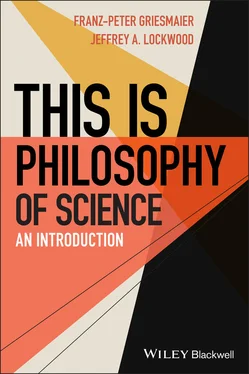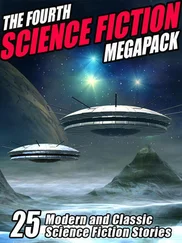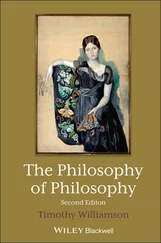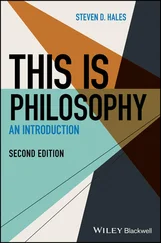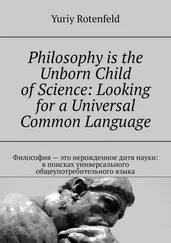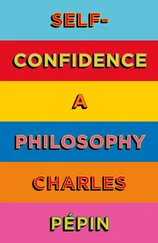Franz-Peter Griesmaier - This is Philosophy of Science
Здесь есть возможность читать онлайн «Franz-Peter Griesmaier - This is Philosophy of Science» — ознакомительный отрывок электронной книги совершенно бесплатно, а после прочтения отрывка купить полную версию. В некоторых случаях можно слушать аудио, скачать через торрент в формате fb2 и присутствует краткое содержание. Жанр: unrecognised, на английском языке. Описание произведения, (предисловие) а так же отзывы посетителей доступны на портале библиотеки ЛибКат.
- Название:This is Philosophy of Science
- Автор:
- Жанр:
- Год:неизвестен
- ISBN:нет данных
- Рейтинг книги:5 / 5. Голосов: 1
-
Избранное:Добавить в избранное
- Отзывы:
-
Ваша оценка:
- 100
- 1
- 2
- 3
- 4
- 5
This is Philosophy of Science: краткое содержание, описание и аннотация
Предлагаем к чтению аннотацию, описание, краткое содержание или предисловие (зависит от того, что написал сам автор книги «This is Philosophy of Science»). Если вы не нашли необходимую информацию о книге — напишите в комментариях, мы постараемся отыскать её.
This is Philosophy of Science
This Is Philosophy???
, This is Philosophy of Science: An Introduction
This is Philosophy of Science — читать онлайн ознакомительный отрывок
Ниже представлен текст книги, разбитый по страницам. Система сохранения места последней прочитанной страницы, позволяет с удобством читать онлайн бесплатно книгу «This is Philosophy of Science», без необходимости каждый раз заново искать на чём Вы остановились. Поставьте закладку, и сможете в любой момент перейти на страницу, на которой закончили чтение.
Интервал:
Закладка:
Suppose you are in a driving car, approaching a city. You happen to look at two tall buildings far ahead on the right side of the road. One of them seems to be almost attached to the other, that’s how close they look to you. However, once your car is driving right past them, you notice that the two buildings are actually dozens of yards apart; of course, as the car continues on its way and you look back, the buildings seem to be closer together again. Something very similar should happen, if heliocentrism is true. As the earth moves around the sun, stars that look to be very close to each other at one point during the year should look to be much farther apart at a later point, at a time when the earth is moving “right past them.” This apparent change in the distance between the stars, as observed from the moving earth, is the phenomenon called “stellar parallax.” The problem was, for Copernicus and his contemporaries, that no stellar parallax had ever been observed! Thus, the opponents of heliocentrism argued that the earth can’t be moving through space and around the sun. To them, the absence of an observable stellar parallax clearly falsified heliocentrism.
In response, Copernicus resorted to the move we discussed earlier: Blame some auxiliary hypothesis! He simply proposed that the absence of an observable stellar parallax is due to the fact that the stars are much further away from us than we thought. If so, then the distance travelled by the earth would be negligible in terms of observing parallax. During his time, most estimates of the size of the universe put the stars, which were thought to be located at the outer edge of the universe, at a distance of about six times that between the earth and the moon (they were off by about one quintillion-fold). In such a small universe, one would expect to observe a stellar parallax. In effect, Copernicus pointed out that to infer that we should observe stellar parallax, two claims need to be true: that the earth moves around the sun and that the universe is sufficiently small. Thus, he was able to blame the assumptions about the size of the universe for the failure to observe stellar parallax. Heliocentrism had not been falsified.
There is another infamous case in which an important scientist tried to save a theory from counterexample, but in which the attempted “rescue mission” led to a rather curious claim. We are thinking of Joseph Priestley, a lifelong defender of the so-called phlogiston theory of combustion. According to this theory, when things burn, they release a very subtle substance, called “phlogiston.” The more phlogiston a material contains, the easier it burns. Given the importance of combustion for chemical experiments, phlogiston was a central concept in early chemistry. In the 1780s, the French chemist Antoine-Laurent de Lavoisier conducted experiments in which he burned mercury. Upon measuring the weight of the residue, he realized that it was heavier than the sample of mercury he started with. This was extremely puzzling: If combustion involves the release of a substance, why should the resulting “ashes” be heavier than the material before it was burned? This fact seemed to conclusively refute the phlogiston theory.
Priestley, however, had an “ingenious” idea to save the theory. Phlogiston, so he claimed, has negative weight. Thus, since phlogiston is released during combustion, the residue will be heavier than the original sample. Of course, since most things that we ordinarily burn, such as wood, also contain water, their ashes will be, all things considered, lighter than what we put into the fireplace, because the water evaporates. Obviously, Priestley made the same move as Copernicus. In order to observe weight loss during combustion, when adjusted for the loss of other components, two things have to be true: phlogiston is released during combustion and phlogiston has positive weight. Thus, he was able to blame the assumption about the weight of phlogiston for the failure to observe weight loss. The phlogiston theory had not been falsified.
3.3.4 Lucky Modifications
We quite deliberately phrased the ending of Copernicus’ successful rescue of heliocentrism and the ending of Priestley’s attempted rescue of the phlogiston theory almost identically, only replacing some of the words, in order to bring out how eerily similar the two episodes are. And yet, from today’s perspective, Copernicus’ rescue appears heroic, while Priestley’s seems foolish. For one, we now know that Copernicus was right, and that Priestley was wrong. However, we need to be careful not to let hindsight play a role in evaluating their rescue attempts. From a logical perspective, they seem identical. Given their respective historical contexts, both the claim that the universe is vastly bigger than usually estimated, and that phlogiston has negative, rather than the standardly assumed positive, weight, are hopelessly ad hoc . It’s just that Copernicus got lucky and was proven right by subsequent developments, while Priestley had massively bad luck and now looks like a fool.
Could their respective fates have been predicted at the time? If Popper is right about legitimate vs. illegitimate modifications in the face of observational counterevidence, it would have to be the case that Copernicus’ modification was arguably progressive, while Priestley’s was not. Remember that a modification is progressive to the extent to which the modified theory has more content, and thus faces more potential falsifiers, than its predecessor. Copernicus’ modification postulated a very large universe. Priestley’s modification postulated a substance with negative weight. Regarding Copernicus, it is difficult to determine whether heliocentrism in a large universe has more falsifiers than heliocentrism in a small universe. Thus, it is difficult to say whether this modification was indeed progressive in Popper’s sense. The difficulty might reside in Popper’s choice of the “scientific unit” that is to be judged as progressive or not. The unit for Popper is an individual theory. His student, Hungarian-born Imre Lakatos, proposed using a wider unit, viz., a research programme . Perhaps Copernicus’ modification can be seen as progressive in virtue of being embedded in a progressive research programme, as we’ll discuss in Chapter 15on scientific progress.
Let’s now turn to Priestley’s negative weight. There is one sense in which this proposed modification is not progressive, but rather badly ad hoc. Phlogiston was supposed to be the only substance that has negative weight. But could this hypothesis at least be falsified? In Copernicus’ case, the development of increasingly powerful telescopes provided good empirical reasons for adjusting the estimates about the size of the universe upward, until, by current estimates, we arrived at 91 billion light years. In principle, it could also have been falsified. This would seem to be impossible in the case of phlogiston. The obvious way would be to isolate phlogiston and then try to weigh it – but with what? We don’t have instruments for determining the value of negative weight. Moreover, with negative weight, would phlogiston also have to have negative mass? (Remember, weight is simply a function of mass and the gravitational constant). What would that be? Sure, the negative weight idea saved the theory from the mercury counterexample. But it would have been quite obvious that independent evidence was elusive if not impossible. In light of this, perhaps the right verdict is to say that the statement “Phlogiston has negative weight” looks quite a bit like the statement “The absolute is beautiful.” Neither one can in any clear way be falsified. Thus, by Popper’s criterion for progressive modifications, Priestley’s modification fails, as it introduces a nonfalsifiable, and thus merely protective, hypothesis.
Читать дальшеИнтервал:
Закладка:
Похожие книги на «This is Philosophy of Science»
Представляем Вашему вниманию похожие книги на «This is Philosophy of Science» списком для выбора. Мы отобрали схожую по названию и смыслу литературу в надежде предоставить читателям больше вариантов отыскать новые, интересные, ещё непрочитанные произведения.
Обсуждение, отзывы о книге «This is Philosophy of Science» и просто собственные мнения читателей. Оставьте ваши комментарии, напишите, что Вы думаете о произведении, его смысле или главных героях. Укажите что конкретно понравилось, а что нет, и почему Вы так считаете.
